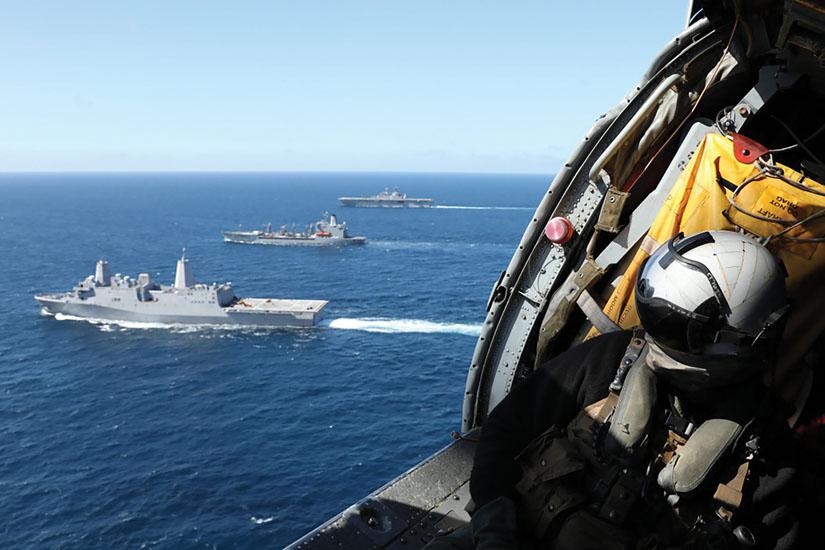Quantum Information Science Matters
Across the U.S. Air Force’s research arm, scientists are developing quantum information science capabilities in four key areas of interest to the service: timing; sensing; communications and networking; and computing. Experts at the Air Force Research Laboratory, known as AFRL, are also investigating the development of enabling technologies, which will springboard the use of quantum capabilities in the four areas. The goal is to first take quantum-based timing and sensing technologies, which are at a near breakthrough point, and move them from the lab into field applications in the next few years, while pursuing longer-term development of quantum computing, communications and networking.
Alongside the AFRL’s technical research and development (R&D) in quantum information science (QIS), workforce development, assisting, training and retaining qualified QIS-related personnel is just as critical, as is the participation in and leveraging of partnerships and consortium groups. The AFRL also stands to shape quantum-related policies and priorities within the Defense Department, says Michael Hayduk, deputy director, Information Directorate, at the AFRL in Rome, New York.
“The way we have our strategy developed at AFRL is that we view the timing and sensing applications as our near-term applications, where we will be able to see benefits to the warfighter in a much shorter time frame than we will in some of our longer-term applications, which would include communications and networking, and computing,” Hayduk states.
Quantum-based technologies represent the next frontier of almost unimaginable, powerful capabilities, which will transform military effectiveness, he notes. “When we see quantum information science or quantum technologies, what really makes QIS special is that they leverage the unusual properties of the quantum mechanics that govern the fundamental building blocks of matter,” he explains. “These would include electrons, photons, neutrons and protons; those really fundamental and foundational building blocks of all matter. And by being able to leverage quantum mechanics, we can then really come up with a whole different way of doing things, across those four areas of timing, sensing, communications and networking, and computing.”
At the AFRL in Rome, Hayduk serves as the AFRL quantum coordinator, organizing the QIS research nationwide across all AFRL directorates. The deputy director, who began the AFRL’s quantum computing program in 2009 when he was the division chief for the directorate’s Computing and Communications Division, is working under Col. Timothy Lawrence, USAF, director, AFRL Rome, on their research portfolio, which is centered on command, control, communications, computers, intelligence (C4I ) and cyber.
Six directorates within the AFRL are working on different aspects of QIS, Hayduk notes. “In Rome, in the C4I and cyber area, we’re focusing on computing and communication technologies for quantum information science, which includes quantum computing and quantum communications and networking,” he states.
The AFRL’s Materials and Manufacturing Directorate at Wright-Patterson Air Force Base, Ohio, is conducting R&D in QIS materials development and supply chain issues. A group of researchers at the AFRL’s Directed Energy Directorate at Kirtland Air Force Base, New Mexico, is working on quantum networking, satellite-based quantum communications and optical technologies. Meanwhile, the Space Vehicles Directorate at Kirtland is performing quantum-related timing and sensing R&D, and the Sensors Directorate at Wright-Patterson, which specializes in intelligence, surveillance and reconnaissance (ISR), is examining quantum emitters and device fabrication.
In addition, the Air Force Office of Scientific Research in Arlington, Virginia, is conducting fundamental research and foundational work in QIS—basic research that cuts across all areas, Hayduk offers.
Given the Air Force’s importance of having self-sustaining position, navigation and timing, the quantum-related R&D in timing and sensing at the AFRL is examining how to bring those two functions together to maintain and improve timing and accuracy in GPS-controlled and -denied environments.
“We view quantum as really being able to play into those technologies,” Hayduk states. “The various quantum technologies that you can introduce into those systems will ideally give you higher sensitivity that will allow you then to have better sensor precision, which allows you to know your location better. For the Air Force, obviously it’s very critical in terms of having GPS precision across the weapon systems as well as having time synchronization for force projection.”
For timing, the AFRL is preparing atomic clocks with improved stability, less drift and in a smaller form factor. These quantum-based clocks will require fewer timing updates, which will allow time transfer between platforms, enabling advanced electronic warfare and improving ISR and navigation.
“We’ll have clocks that will be able to track time and hold whole time for weeks to a month at a time, even in very dynamic and changing conditions,” Hayduk suggests. “A lot of these clocks are very, very precise as you move from nanosecond stability to picosecond stability, and so, it really comes down to the size, weight and power of these sensors, including performance. Being able to move from what I view as a very large optical table that is maybe four feet by eight feet with all the necessary components to go with it, then miniaturizing and ruggedizing that and taking it out into the field, that’s really where the technology challenges are right now. Not only are you taking research technology from the lab but at the same time you’re trying to make it fieldable and deployable.”
On the sensing side, researchers are examining quantum-related inertial sensors, magnetometers, gravitational sensors and electric field sensors, to be able to provide navigation when a GPS signal is lost.
“Gravimeters are useful at long standoff ranges, and we potentially see them as being very useful for locating underground structures, which certainly will be of interest to the [Defense Department],” Hayduk notes. “Knowing exactly where you are and being able to map gravity or use gravity mapping will allow you to have precise knowledge of your position. And then we see strategic-grade inertial navigation systems being able to use gravity maps as another way of being able to navigate when you’ve lost GPS-type signal. So, we’re putting a lot of resources into these areas.”
The Sensors Directorate at Wright-Patterson is developing a related open architecture technology—a platform that will bring these various quantum-based technologies together, resulting in improved timing and navigation information capabilities, Hayduk notes.
The AFRL is planning on putting some of its quantum timing and sensing technologies to an initial test during the military’s Rim of the Pacific exercise in 2022. Known as RIMPAC, the biennial naval exercise is extensive, and in 2018 included 26 nations, 47 surface ships, five submarines, 18 national land forces, 200 aircraft and 25,000 personnel. For RIMPAC 2022, the AFRL is working with the Office of Naval Research to conduct the QIS testing in conjunction with the Five-Eye Nations: the United States, Canada, United Kingdom, Australia and New Zealand.
“We’ll actually take these timing and sensor systems from the laboratory, and in this first exercise, bring them out to the field, put them aboard an actual naval vessel and get useful PNT information out of it,” Hayduk shares. “It’s going to be an interesting experiment. We’re not sure in the first year how it’s really going to go. We really have to move technologies rapidly from the lab to the field, but it’s going to give us great insights into some of the shortcomings and then allow us to go back to do further research and further technology development. And then in the next exercise, which will be in 2024, we’ll bring the technologies out and see how far they progressed.”
Regarding QIS computing, the AFRL’s longer-term research involves algorithm and software development, machine learning and artificial intelligence, and simulation applications. “Quantum computing is an area that we’re really excited about that we’ve been working on for quite a while in Rome,” he says.
However, the research is not to develop the specific computing equipment, Hayduk clarifies. Instead, the lab is partnering with quantum computer companies—such as IBM, Google, D-Wave, Intel, INQ, and Rigetti—for supplies. The lab also is one of the first hubs on the collaborative IBM-Q network. “All those companies have major efforts in developing quantum computing hardware,” he notes. “So, what we’re looking to do within the Air Force is how do we take those prototype quantum computers … and exercise problem sets that we’re very interested in at AFRL and to see if we can have a quantum advantage over what traditional computers or super computers can do right now.”
The prototype computers, referred to as noisy intermediate-scale quantum computers—or NISC computers—have on the order of 50 to 100 quantum bits, or qubits. The AFRL is using the NISC machines to develop quantum-related algorithms and software for beneficial Air Force application areas, such as optimization.
“With Joint All-Domain Command and Control, or JADC2, we look at how we optimize asset allocations, whether it be weapon systems, people, or platforms across all of the domains—air, space, cyber, land and sea—and how can we optimize those allocations,” the deputy director explains. “Quantum computing algorithms are one way of doing that. They are very difficult problems to do right now even with super computers, so there’s a lot of interest in using quantum computing for that application.”
Moreover, with quantum-based machine learning and artificial intelligence solutions, Hayduk predicts much quicker training of algorithms. “Right now, it is very labor intensive and takes a long time to train those neural networks,” he says. “Quantum computing may be able to enhance that.”
QIS also can greatly impact simulation applications used in developing materials, the deputy director ventures. “Since quantum computers are actually quantum systems and operate on the principles of quantum mechanics, why not use quantum computers for quantum simulation?” he asks. “It would allow you to look at atoms and molecules and properties of materials to eventually be able to develop better materials. Once you have an understanding of the foundational properties of those materials, you can then expand it to develop other areas that could be of great interest. For example, we’re partnered with the Navy right now in looking at materials development and the Navy—they are very interested in looking at materials that are corrosion resistance, so you can imagine how that would benefit the Navy in a future fight.”
Additionally, researchers at Rome are developing photonic integrated circuits, which rely on light signals to process quantum information. “We are using these circuits for nodes in a computing network,” Hayduk shares. “We see quantum computers most likely as being very distributed systems in the future, similar to our super computers. If you distribute those quantum computers, you are going to have a need to process at those nodes and we see photonic integrated circuits as a way to do that.”
The AFRL has partnered with AIM Photonics, the Defense Department’s manufacturing institute, to demonstrate several large-scale wafers with integrated photonics technologies. The photonics capabilities will enable the size reduction of optical benches—such as in the aforementioned atomic clocks—down to 300 millimeter-sized wafers, Hayduk attests. Here, the lab is collaborating with several partners, including Rochester Institute of Technology, University of Illinois, Purdue University, Oak Ridge National Laboratory and Massachusetts Institute of Technology.
As for QIS communications and networking long-term R&D, the AFRL is examining a unique property of quantum technology called entanglement distribution, a fundamental building block for quantum networks and quantum Internet. “Einstein called it ‘spooky action at a distance’,” Hayduk notes. “It will allow us to take networks to new heights. We will be able to link not only the quantum clocks and quantum sensors together and develop new capabilities but also link quantum computers.”
For this application, AFRL Rome is working on developing memory nodes for quantum networks, not only at the ground level and air-to-ground but into space. “It is about how you get to space and how you can communicate safely and securely without being tampered, and having a tamper-resistant network in space is very much of interest,” the deputy director says. “A lot of research still needs to be done in [this area].”







Comment
Amazing resources and
Amazing resources and information
Comments